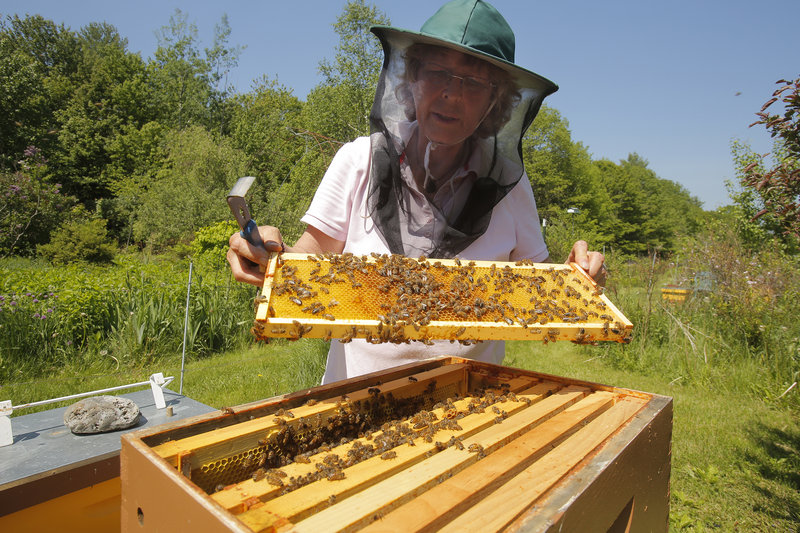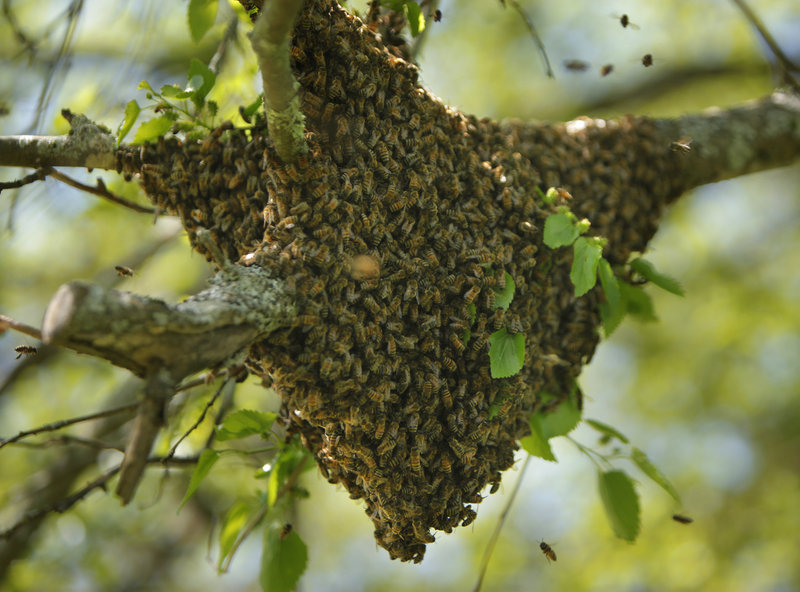– By NORTH CAIRN
Staff Writer
A recent federal report has pinpointed some of the causes of rapid die-off of bee populations from colony collapse disorder, but Maine beekeepers say hives here are flourishing.
They credit healthy management by commercial beekeepers and the diversity of Maine’s agricultural base with helping to avoid the threats posed by the disorder in many other states.
“We’re in very good shape,” said Tony Jadczak, state apiarist for the Department of Agriculture, Conservation and Forestry. “We have good bees, good bloom. Now we just need some (good) weather.”
It will take more than good weather to counter the impacts of colony collapse disorder on bee populations elsewhere in the nation and across the globe, based on current trends.
According to a recent joint report of the U.S. Environmental Protection Agency and the U.S. Department of Agriculture, honeybee populations have been decimated by the disorder, a cluster of symptoms culminating in adult male bees suddenly fleeing the colony and dying elsewhere, causing the overall decline or total die-off of the hive.
Colony collapse disorder has killed millions of bees globally and devastated commercial beekeeping in many parts of the world.
Jadczak, who has been involved with bees and keepers for 40 years, said he believes the origin of the collapse lies much further back than its apparent first occurrence in 2006 and its reported spread within a year to 24 states. He traces the problem back to 1985, when the first infestation by two species of mites affected the state’s bee populations.
The mites carry immuno-suppressors in their saliva, reducing the disease-fighting capacity of bees. In addition, they serve as vectors of viruses that typically remain latent until the bees are weakened and the viruses surge forward, overwhelming affected hives.
Over the next 20 years, other stresses were heaped on honeybees, including a widespread intestinal parasite and extensive use of pesticides designed to kill the mites. But mites are difficult to eliminate, Jadczak said, because they quite quickly become immune to pesticides.
These factors have combined to drive honeybees to a tipping point, Jadczak said.
The potential losses from the disorder are enormous. An estimated one-third of all food and beverages — worth $20 billion to $30 billion each year in crop production — are made possible by pollination, mainly by honeybees, the federal report found.
In the last seven years, the disorder has caused the populations of an estimated 10 million beehives, valued at about $200 each, to be wiped out, costing beekeepers roughly $2 billion.
Compared with the nation’s roughly 6 million honeybee colonies a half century ago, only 2.5 million remain, raising serious questions about whether U.S. farm crops will receive adequate pollination, the report said.
Erin Forbes, past president of the Maine State Beekeepers Association, said there’s little doubt that pesticides play a significant role in damaging bee populations, partly because the toxic chemicals they contain blend with other pesticides in the environment.
“It’s what humans are putting into the agricultural system,” Forbes said. “It’s like mixing bleach with ammonia. These chemicals are in soil, plants, groundwater.”
Providing sufficient acreage for safe foraging and pasture for bees is critical to their survival, she said.
In Europe, several countries recently joined forces to enact a two-year ban on certain pesticides, in hopes of sidelining one of the presumed key factors in the bees’ collapse.
But the federal report, issued in early May, did not single out one specific cause. Rather than calling for a ban on any pesticide, it called for more study into bees’ exposure to toxic chemicals and their effects. The agencies and organizations contributing to the report determined the disorder to be the result of a combination of conditions — biological, chemical, entomological and agricultural.
“It’s multiple factors,” Jadczak said. “There’s no single smoking gun.”
In the past five years, the disorder has wiped out nearly a third of hives in U.S. commercial beekeeping operations, 30 percent on average in the last year alone, said David Bell, executive director of the Wild Blueberry Commission of Maine. That’s nearly twice the normal mortality rate.
“We’re very concerned about pollinators,” said Bell. “Actually, all human beings should be concerned about pollinators.”
Prospects have been considerably brighter for well-managed enterprises among Down East blueberry growers and beekeepers, said Bell. Their reported losses ran about 11 percent last year — far below the national average under the stresses of the disorder.
“The bees look fantastic; the colonies look fantastic,” said Forbes.
Open communication between growers and beekeepers, coupled with attentive management, has ensured that no great economic loss hit the approximately 60,000 acres of wild blueberries in Maine, Bell said.
“There’s a huge range in the skill of farmers,” said Bell. “There’s also a huge range in the skill of commercial beekeepers.”
Paul Dumont, a commercial migratory beekeeper from Windsor, said poor management of hives can contribute to colony collapse disorder. “Part of the problem with these bees is … not letting them rest … to regroup their energies,” he said.
Bees carted from place to place to do their work demand proper management, including enough food, water and time off. Without proper care, Dumont said, colonies become more susceptible to disease, parasites and other hardships.
In the course of a year, bees from Dumont’s 1,800 hives travel from Florida to California, then on to Maine, New York and Massachusetts in truckloads of pallets spread out over fields and bogs.
That’s not unusual in Maine, where the largest population of bees are migrants — more than 70,000 hives, each carrying 35,000-40,000 bees, trucked in annually to pollinate 60,000 acres of the state’s blueberry, raspberry, cranberry, canola, pumpkin and squash crops, as well as apple and other orchards.
“The health of bees is a definite concern,” said Margie Hansel, president of the Maine State Pomological Society. Growers of the state’s approximately 2,000 acres of apple orchards have experienced some problems associated with the disorder, but none has reported the entire cluster of symptoms that characterizes the problem.
The state’s relatively colder climate and harsh winters may serve as a natural protection, preventing the conditions under which some of the symptoms of the disorder become more virulent, Hansel said.
In addition to migrant bees, Maine has 12,000 to 18,000 resident hives, tended mostly by amateur beekeepers or hobbyists, said Jadczak.
And more keep coming.
Incorporating bees into the backyard has become so popular in the last five years that the Cumberland County Beekeepers Association alone has grown to 225 members.
Forbes said as many as 300-400 new beekeepers begin operations each year in Maine, reinvigorating depleted bee colonies with backyard hives. Honey is selling for $8 to $20 a pound.
Peggy Pride of Lebanon started backyard beekeeping six years ago in hopes of getting better yields from a variety of homegrown food crops.
“We wanted better pollination of our fruit trees,” she said, adding that she has been surprised at how great a boon the bees were, enhancing production in the apple orchard, as well as in raspberries, pears and peaches.
The Prides have experienced losses higher than 25 percent some years in their more than 30 hives; 20 percent just over the past winter. But the bees do rebound, she said.
“Every year is different when you’re working with Mother Nature,” she said. “You have to take what you get. With Mother Nature, you never know.”
North Cairn can be contacted at 791-6325 or at:
ncairn@pressherald.com
Send questions/comments to the editors.




Success. Please wait for the page to reload. If the page does not reload within 5 seconds, please refresh the page.
Enter your email and password to access comments.
Hi, to comment on stories you must . This profile is in addition to your subscription and website login.
Already have a commenting profile? .
Invalid username/password.
Please check your email to confirm and complete your registration.
Only subscribers are eligible to post comments. Please subscribe or login first for digital access. Here’s why.
Use the form below to reset your password. When you've submitted your account email, we will send an email with a reset code.